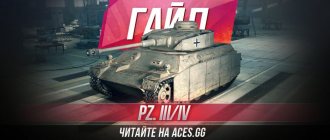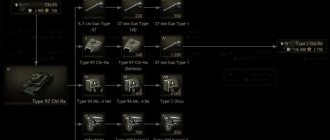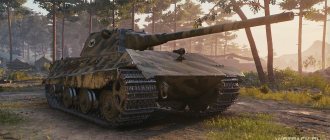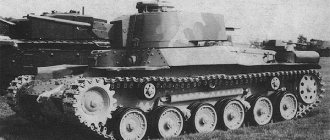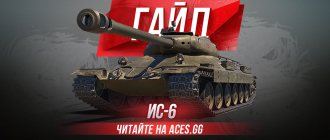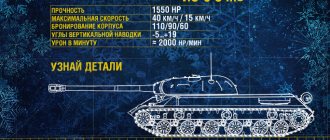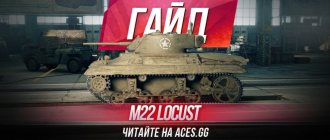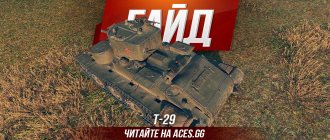M4A2E4 is an American Tier V medium tank. The car is not pumpable and is in the category of premium equipment. Let us immediately note that the technique is very complicated. With a good deal and skillful hands, the M4A2E4 Sherman can bring in a very good income: up to half a million silver per gaming session.
Agree that this is simply an excellent indicator for a tier 5 car. However, beginners are unlikely to be able to achieve such results: ignorance of maps and basic game mechanics turns the “American” into just a fun toy that helps upgrade the tank crews of your nation. To better understand the strengths and weaknesses of the vehicle, we bring to your attention the M4A2E4 guide, which will help you understand all the intricacies of playing this premium tank.
M4A2E4 Sherman performance characteristics
Let's start with the fact that the M4A2E4 tank has a very average safety margin in comparison with its classmates: 480 units . At the same time, the overview in the basic configuration is 370 meters. It should be clarified that by installing modules and pumping up the crew, this value can be increased to 430 m , which is an undeniable advantage for a medium tank.
The vehicle weighs 31 tons with an installed engine power of 420 horsepower. The result is a weight to towing ratio of around 13 liters. With. per ton. What does this give? The tank received an excellent maximum speed: the “American” is capable of accelerating to 52 km/h . There are no comments on maneuverability either: the chassis rotates at a speed of 43.8 degrees/sec . The only drawback is the dynamics. The M4A2E4 Sherman accelerates very hard and loses speed on inclines and difficult terrain.
Let's move on to weapons. Let us immediately note that in this regard m4a2e4 looks deprived. So, we are armed with a 75 mm Gun M3 gun , capable of penetrating only 92 mm of armor with an armor-piercing projectile.
By loading the sub-caliber, this value increases to 127 mm , one-time damage in both cases will be 110 units . What does this mean? Armor-piercing shells will be useless even for most of their classmates; shooting gold is not always profitable: for premium vehicles this is a sure way to leave the battle with a minus silver balance. Therefore, there remains hope for land mines: penetration of 38 mm with an average damage of 175 units .
The positive characteristics of the gun include an excellent rate of fire: 15 rounds per minute. Taking into account the alpha strike, this provides a theoretical DPM of 1,700 units . However, these are very approximate indicators, because when shooting an BB, the offensive phrase “Didn’t penetrate” will very often be heard. The aiming time is quite acceptable - 2.1 seconds , while the gun has simply terrifying stabilization and accuracy. Accordingly, when playing on this tank, you should immediately forget about remote firefights and effectively finishing off the enemy on the move.
The vertical declination angles here are typically American: 10 degrees down , so m4a2e4 can intelligently use the terrain of game locations.
gun
The armament of our tank deserves special attention, but don’t expect anything good, this American’s gun is weak, which is why its purpose is not entirely clear, because this is a premium vehicle that, in theory, should be able to farm.
So, M4A2E4 Sherman gun
has the average alpha strike of a level 5 medium tank, as well as a decent rate of fire, which allows it to deal approximately 1,750 units of pure damage.
The problems begin with the penetration parameters, since the basic M4A2E4 Sherman tank
has difficulty even breaking through some of his classmates. For this reason, you will often have to shoot gold, so this device does not farm well.
In terms of accuracy, our American is also far from the concept of a comfortable game. The gun has a very wide spread, it takes a very long time to bring down and there is no stabilization here. At least I'm glad that the M4A2E4 Sherman WoT medium tank
got good vertical aiming angles.
Equipment for M4A2E4 Sherman
The “American” has many problems that need to be eliminated by any means available in the game. Considering that we are talking about a medium premium tank, whose main task is to bring profit to the owner, the weapon and viewing radius definitely need modernization. Damage and the ability to shine are the main components for successful farming.
So, we recommend trying to install the following set of additional modules:
- Rammer – we increase the rate of fire to standard values.
- Ventilation – we get a comprehensive increase in all basic characteristics.
- Illumination – we increase the viewing radius to guarantee that we can overexpose the enemy.
Alternatively, the ventilation can be replaced with an aiming stabilizer to partially offset the “curvature” of the barrel and increase the effectiveness of shooting on the move and at long distances. In addition, you can install anti-fragmentation lining to reduce the likelihood of receiving critical damage from artillery hits.
Perks for the crew on M4A2E4
The second important factor to improve the combat characteristics of the M4A2E4 Sherman is to improve the skills of tankers. By the way, 5 people can be accommodated under the armor of the vehicle, so you can upgrade all the ST crews of your development branch. For a comfortable game, we recommend studying the perks in the following order:
In addition, do not forget to download the proposed consumables, which will help maintain a relatively small margin of safety in battle. Therefore, be sure to take with you a first aid kit, a repair kit and a fire extinguisher. By the way, it is not recommended to replace the fire extinguishing agent with a box of cola: the American has a fairly high probability of an engine fire, and such a fire could well be fatal.
M4A2E4 Sherman armor
In terms of security, the M4A2E4 tank looks very interesting. The strongest part is the frontal projection of the hull. The description of the equipment in the game indicates that there is as much as 65 millimeters of armor. However, the correct placement of NLD armor plates gives a reduced value of about 150 mm.
The upper frontal part is more vulnerable: here the armor ratings vary between 67-116 mm. The forehead of the turret is protected by a plate 75 millimeters thick, but taking into account rational angles and the gun mantlet, you can get ricochets and no penetration. Let’s immediately make a reservation that you shouldn’t rely too much on this and mindlessly tank with a turret.
The sides and stern look sad. There is only 38 millimeters of armor; there are no side screens that provide additional protection. Therefore, in any battles, there is no need to try to tank in a diamond formation and turn sideways towards your opponents.
For comparison: the armor penetration of the Soviet level 1 tank MS-1 is 52 millimeters. Therefore, even this little guy, if desired, can give the formidable “American” a good shot at his pain points. The only consolation: M4A2E4 is a beneficiary, so he will not have to meet with the “sevens”. The main opponents are classmates and lower level equipment.
How to play on M4A2E4?
The tactics of playing the M4A2E4 Sherman will definitely appeal to tankers who prefer dynamics and excitement. The fact is that the effectiveness of a tank is only evident at close and medium distances, so in order to farm, you will inevitably have to get closer to the enemy.
In general, the game uses ambush tactics here. At the beginning of the battle, we look for an advantageous position in a potentially dangerous direction (preferably in dense bushes) and perform the function of passive light. It will not be possible to play a full-fledged firefly due to poor dynamics: the tank accelerates very slowly, and if its track is knocked down during active lighting, the American will no longer be able to get out from under fire.
At the same time, do not forget that the M4A2E4 is a medium tank with good speed characteristics. Therefore, we periodically change our position, and do not forget to throw damage to the stern and sides of the carried away opponents. For these purposes, you can take at least 30 land mines into battle: the size of the ammunition load of 90 shells allows this to be done. A successful hit with a landmine on a cardboard side can bring about 200 damage, and these are already good prerequisites for farming. In addition, such shells will help you survive in fights with lightly armored but fast-firing opponents. In particular, having met one-on-one with the T67, the Sherman will not physically be able to shoot it with armor-piercing shells, but landmines give a good chance of victory.
It is important to understand that you must try to avoid duels by all means: the M4A2E4 Sherman cannot exchange damage equally with the enemy. By definition, this is a rat tank that should bite painfully and quickly escape.
Sherman M4A3E2 Jumbo Sherman M4A3E2 Jumbo
Photos of the M4A3E2 Jumbo tank (RN/3082923 / SN 50326), taken by the Chrysler Design Department
click the image and see the gallery
In early 1944, the US military began thorough preparations for the upcoming invasion of Europe. The need for a well-armored tank to support the infantry in the upcoming operation became obvious. However, there wasn't much to choose from. By that time, the American military had completely become disillusioned with the T14 heavy tank, which they never wanted to see in their fleet anyway, and work on the new T26E1 tank clearly could not be completed before the summer. Finally, in February 1944, the US Army was forced to admit that it would simply have to add additional armor protection to its standard light and medium tanks in the field in order to use them as assault vehicles. Even wooden models of tanks with upcoming modifications were already ready, when this idea was abandoned. Further research showed that a standard M4A3 tank could be converted into an assault tank by adding armor and changing the tracks and power train. We settled on this option. At a meeting of the Artillery Committee in March 1944, the tank received the designation Assault Tank M4A3E2 (M4A3E2 assault tank) and production of 254 of these vehicles was approved.
Two hits from armor-piercing shells on the M4A3E2 Jumbo's mask. Armor is not broken.
click the image and see the gallery
The tank's protection was strengthened by welding rolled armor plates 3.81 cm thick onto the forehead and sides of the hull. As a result, the total armor thickness was 10.16 cm on the front plate and 7.62 cm on the sides of the sponsons. The armor thickness of the differential cover and final drives was increased to 13.97 cm. The remaining parts of the body remained unchanged.
The tank received a new turret made of cast armor 15.24 cm thick on the front, sides and rear. To enhance armor protection, they abandoned the pistol loophole. The gun mantlet was essentially a standard M62 mantlet with an additional armor plate welded on the front, giving a total of 17.78 cm of armor. The thickness of the mask increased so much that it did not allow the hatches of the driver and assistant driver to fully open, so the lower extreme corners of the welded armor plate had a smaller thickness.
Differential cover and upper windshield after test firing
click the image and see the gallery
Initially, it was planned to arm the M4A3E2 tank with a new 76mm tank gun, but then it was abandoned in favor of the 75mm. The reason for the refusal was that the 76mm M1 gun had only one advantage over the 75mm M3 - better armor penetration. Otherwise, the 76mm was inferior to the 75mm gun. The 76mm high-explosive shell had 0.39kg of explosives, and the 75mm high-explosive shell had 0.66kg of explosives, and the external ballistics of the 75mm gun were also better than those of the 76mm gun. In general, the old 75mm M3 gun was more universal, so in the end they decided to install it. The turret was equipped with a T110 carriage, which was a modified version of the standard M62 carriage. Since the differences between the carriages were minimal, if necessary, it was easy to rearm the M4A3E2 tank with a more powerful gun.
The tank's secondary armament remains the same as the M4A3, including a 2-inch smoke mortar on the left front on the turret roof. Side lights and sirens were abandoned. Otherwise, the equipment of the M4A3E2 remained the same as the Sherman M4A3 tank.
The increased pressure on the ground was compensated by spurs, which were added to the outer edge of the tracks and increased the total area of the supporting surface. The specific pressure of the M4A3E2 in the extended T48 tracks was 14.2 psi, which was even lower than that of the lighter M4A3 tank - 14.3 psi.
The final drive ratio was increased from 2.84:1 to 3.36:1, reducing the vehicle's speed to 22 mph. Otherwise, the power transmission remains the same as that of the M4A3 tank.
Production of M4A3E2 tanks began in May 1944 at the Grand Blak Tank Arsenal, where 40 vehicles were produced. In June they produced 110 tanks and in July the last 104 M4A3E2. In May 1944, cars SN 50326-50365, RN 3082923 - 3082962 were released, in June SN 50366 - 50476, RN 3082963 - 3083073, and in July the last cars SN 50477 - 50579, RN3083074 - 3083176 were released. A total of 254 M4A3E2 tanks were produced. The tank was tested at two test sites in Aberdeen and Fort Knox. Already on August 29, 1944, the Military Department informed the 12th Army Group that 250 M4A3E2 tanks were ready for use.
On September 22, 944, 128 M4A3E2 tanks arrived at the Eastern Theater of Military Operations. On November 5, 1944 there were already 180 of these machines. And finally, on December 3, 1944, the last M4A3E2 vehicles of the 250 tanks planned for shipment arrived at the ETVD.
The M4A3E2 quickly gained great popularity on the front lines, as they were the only American vehicle capable of withstanding a direct hit from a German 88mm projectile. However, if the M4A3E2 medium tanks withstood fire from most German heavy tanks, they themselves could not adequately respond with fire. A more powerful weapon was required. It is worth noting that the first appearance of the American 76mm M1 cannon at the front was a complete failure. It clearly did not achieve the stated indicators for armor penetration, causing shock and anger among ordinary tankers and command. To quickly solve this problem, the Americans accelerated work on sub-caliber projectiles (HVAP), which they had been working on since 1943. These projectiles had a heavy armor-piercing tungsten carbide core enclosed in a lightweight aluminum casing. These relatively light projectiles developed a high muzzle velocity, and the extremely strong tungsten core with a small cross-sectional diameter penetrated thicker armor. Good armor-piercing characteristics were overshadowed by a shortage of the strategic metal tungsten. The first 2,000 T4 76mm HVAP sub-caliber shells were urgently delivered by plane from America to France in August 1944. It quickly became clear that in a real battle with the Panthers, the new HVAP shells penetrated armor worse than what was written in their characteristics, but the result was still better than M62 APC caliber projectiles. In the fall, the new ammunition underwent a number of improvements and was finally standardized in February 1945 as the M93 76mm HVAP-T.
In the same month, in February 1945, at a meeting where the issue of rearming the remaining M4 Sherman tanks from 75mm guns to 76mm guns was previously discussed, representatives of Patton's 3rd Tank Army decided to immediately rearm their M4A3E2 tanks with 76mm guns. The re-equipment took place in the field with the help of regular rembats. There were no particular difficulties, since the towers were originally designed for the installation of more powerful guns. In addition to the 75mm cannon, they also replaced the heavy .50 cal machine gun with a regular .30 cal machine gun. By March 1945, the 3rd Tank Army had completed the rearmament of 45 M4A3E2 tanks. Other armies followed Patton's example and also rearmed some of their M4A3E2s. In total, about 100 M4A3E2 tanks received 76mm cannons. M4A3E2 were used until the end of the war and proved to be the best.
At the beginning of 1945, a request was received for an additional production of M4A3E2 tanks, but with a 76mm gun and a new suspension with horizontal springs. Later in the request it was proposed to replace the 76mm cannon with a 90mm cannon in the turret of the M26 Pershing tank. However, by that time the production of the M26 Pershing tanks was already in full swing, and the release of the updated M4A3E2 was considered inappropriate. Instead, the designers' efforts were aimed at a more armored version of the Pershing - the T26E5 tank with 27.94 cm of frontal armor.
With the advent of the new T26E3 tanks, later standardized as the M26 Pershing, the Jumbo lost its importance. Thanks to good armor and a fairly powerful 90mm cannon, the new Pershings quickly took over the functions of an assault tank from the Jumbo. Nevertheless, the Jumbo managed to play their role and successfully completed the task assigned to them. The report of the 12th Army Group dated May 14, 1945 states the following: “Designed as an urgent and temporary measure, the M4A3E2 assault tank achieved outstanding success.”
M4A3E2 Jumbo after the war
After the war, the military was more interested in the M4A3E2 Jumbo as a base for experimental ideas.
T33 Flame Thrower Tank - pilot number 1
click the image and see the gallery
On May 31, 1945, in accordance with OCM 27569, it was decided to use 3 M4A3E2 tanks as part of an experimental program, converting them into T33 flamethrower tanks. The tests took place at the Aberdeen Proving Ground.
First pilot T33 Flame Thrower Tank (USA # 3082940, ORD S/N 50343) Second pilot T33 Flame Thrower Tank (USA # 3083011, ORD S/N 50414) Third pilot T33 Flame Thrower Tank (USA # 3083021, ORD S/N 50424 )
The T33 tank program was not developed and was discontinued.
T68 flamethrower self-propelled gun
click the image and see the gallery
In November 1953, experiments were carried out at the Aberdeen Proving Ground with two pilot T68 flamethrower self-propelled guns. Both vehicles were modifications of the T33 flamethrower tanks, created on the basis of the M4A3E2 Jumbo. The first pilot of the T68 Self-Propelled Flame Thrower had the numbers -USA #3082940, ORD S/N 50343, the second pilot - USA #3083021, ORD S/N 50424. In December 1953, based on test results, the T68 program was closed.
In the post-war period, part of the M4A3E2 was transferred to the National Guard.
M4A3E2 in the American National Guard
click the image and see the gallery
| 76mm Gun M1, M1A1, M1A1C, and M1A2 76mm Gun M1, M1A1, M1A1C, and M1A2 | ||
| accommodation | line of medium tanks M4 on an M62 carriage, medium tanks T20, T20E3, T22, and T23-2 on a T79 carriage, medium tanks T23 and T23E3 on a T80 carriage, Motor Carriages M18, T86, and T86E1 on an M1 carriage | |
| chamber length (without rifling) | 22.46 inches | |
| threaded length | 133.54 inches | |
| chamber length (to the edge of the projectile) | 20.7 inches | |
| channel length | 135.3 inches | |
| barrel length | 156.00 inches, 52.0 caliber | |
| shutter release length | 7.75 inches | |
| length from the barrel to the back of the bolt | 163.75 inches, 54.6 caliber | |
| extra length, with M2 muzzle brake | 11.6 inch, M2 muzzle brake on M1A1C and M1A2 | |
| total length | 163.75 inches (M1, M1A1), 175.4 inches (M1A1C, M1A2) | |
| channel diameter | 3 inches | |
| chamber volume | 142.6 cu. inches (APC M62), 140.50 inches (HE M42A1) | |
| barrel weight (without muzzle brake) | 870 lbs (M1), 940 lbs (M1A1) | |
| weight of the entire gun (without muzzle brake) | 1,141 lbs (M1), 1,206 lbs (M1A1C), 1,231 lbs (M1A2) | |
| M3 muzzle brake weight | 62 pounds | |
| total weight | 1,141 lbs (M1), 1,268 lbs (M1A1C), 1,293 lbs (M1A2) | |
| shutter type | semi-automatic, the gun is mounted so that the bolt opens horizontally on the M62, T79, and T80 carriages, and at an angle of 45 degrees on the M1 carriage | |
| rifling | 28 rifling, right hand, 1 turn/40 caliber (M1, M1A1, M1A1C) or 1 turn/32 caliber (M1A2) | |
| ammunition | unitary | |
| fuse | impact type | |
| total ammunition weight | APC M62 Projectile (APCBC/HE-T) - 11.2490908 kg HVAP M93 Shot (APCR-T) - 8.57743172 kg AP M79 Shot (AP-T) - 10.995079 kg HE M42A1 Shell (HE) - 10.0833584 kg HC BI M88 Shell, Smoke — 6.07813776 kg | |
| projectile weight | APC M62 Projectile (APCBC/HE-T) - 7.00346619 kg HVAP M93 Shot (APCR-T) - 4.26376828 kg AP M79 Shot (AP-T) - 6.80388555 kg HE M42A1 Shell (HE) - 5.8377338 kg HC BI M88 Shell, Smoke — 3.34751169 kg | |
| highest pressure of powder gases | 43,000 psi | |
| highest rate of fire | 20 shots/min | |
| starting speed | APC M62 Projectile (APCBC/HE-T) — 792.48 m/s HVAP M93 Shot (APCR-T) — 1,036.32 m/s AP M79 Shot (AP-T) — 792.48 m/s HE M42A1 Shell (HE) — 822.96 m/s HC BI M88 Shell, Smoke — 274.32 m/s | |
| muzzle energy of the projectile, KE= 1/2 MV2 | APC M62 Projectile (APCBC/HE-T) 724 ft-tons HVAP M93 Shot (APCR-T) 7 5 3 ft-tons AP M79 Shot (AP-T) 703 ft-tons HE M42A1 Shell (HE) 650 ft-tons | |
| firing range | APC M62 Projectile (APCBC/HE-T) 16,100 meters HVAP M93 Shot (APCR-T) 13,100 meters AP M79 Shot (AP-T) 12,770 meters HE M42A1 Shell (HE) 14,200 meters HC BI M88 Shell, Smoke (at 12 degrees ) 2,000 meters | |
| armor penetration of the 76mm M1A1 cannon against homogeneous armor at an angle of 30 degrees | |||||||||||
| projectile type | Name | Weight, kg | initial speed, m/s | range, m | |||||||
| 457.2 | 914.4 | 1 371.6 | 1 828.8 | ||||||||
| armor-piercing with armor-piercing cap | APC M62 | 7.00346619 | 792.48 | 93mm | 88mm | 82mm | 75mm | ||||
| armor-piercing sub-caliber | HVAP M93 | 4.26376828 | 1 036.32 | 157mm | 135mm | 116mm | 98mm | ||||
| armor-piercing | AP M79 | 6.80388555 | 792.48 | 109mm | 92mm | 76mm | 64mm | ||||
| The table shows armor penetration for the M1A1 gun. The M1A2 cannon's armor-piercing cap (APC) rounds perform slightly better at longer ranges. | |||||||||||
topic navigation
M4A3E2 Jumbo - tactical and technical characteristics M4A3E2 Jumbo - gallery M4A3E2 Jumbo - photo album M4A3E2 Jumbo - camouflage
sources
Peter Chamberlen and Chris Ellis - British and American Tanks of World War Two - Silverdale Books, 2004
Hunnicutt, R. P. Sherman - A History of the American Medium Tank - Presidio Press, 1994
Is M4A2E4 worth buying?
To get a complete picture, let's draw conclusions about the M4A2E4 Sherman. Let's start the comparative review of characteristics with sweets.
So, the positive points are:
- Speed. Here the “American” can easily compete with the light Soviet T-50 tank. At the same time, the car turns quite quickly and goes smoothly through the swamps due to the increased size of the caterpillar tracks.
- View radius. This is a good alternative to frankly weak weapons. In fact, you don’t have to shoot at all, gaining experience and silver for detected enemies, and damage from exposure.
- Reduced level of battles. The tank will not be randomly encountered with Tier 7 vehicles.
- Frontal reservation. Classmates will not be able to penetrate the M4A2E4 head-on with armor-piercing shells. However, frontal armor no longer works against gold.
- Stable increase in efficiency. To get a significant increase in WIN8 performance, you need to make only 7 effective shots. Given the good rate of fire, you can increase your personal statistics already in the first minutes of the battle.
The disadvantages are:
- A bulky silhouette that makes it difficult to hide in the bushes.
- Weapon: an oblique weapon with low armor penetration rates cannot be considered as an advantage of premium equipment.
- Lack of armor in the stern and sides: any land mine hits with maximum damage and can lead to fatal consequences. By the way, the forehead of the M4A2E4 can withstand such hits quite well, even from artillery.
- Frequent critical damage to the ammunition rack and engine.
Considering that the victim of our review was a premium tank, let’s say a few words about its ability to farm. Surprisingly, among the equipment of its level, the M4A2E4 Sherman brings the owner the highest income.
The tank shines on others, receiving bonuses for damage caused by the team, and shoots well at its own light. As a result, its average profitability is about 20,000-25,000 silver without taking into account the premium account. The figure is quite decent, so in the right hands the M4A2E4 Sherman turns into a formidable and profitable machine.
Advantages and disadvantages
As can be seen from everything said above, this premium tank is really not very comfortable, and when the vehicle is rather weak, it is even more important to know its advantages and disadvantages. Now we will pay attention to these nuances and highlight the main strengths and weaknesses of the M4A2E4 Sherman World of Tanks
. Pros: • Excellent viewing range; • Preferential level of battles; • Comfortable vertical aiming angles; • Decent damage per minute; • Good maximum speed. Cons: • Weak armor; • Barn dimensions; • Mediocre dynamics; • Weak penetration; • Poor accuracy.
